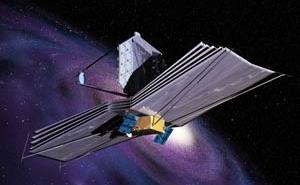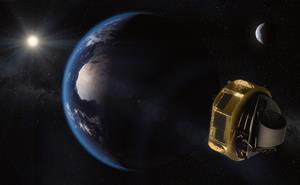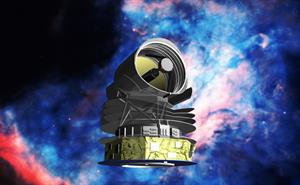Launched on 24 April 1990, a generation of astronomers have never known research without the Hubble Space Telescope. It has made more than 1.4 million observations, given rise to more than 17,000 scientific papers and has led to space science breakthroughs including determining the rate of expansion of the universe.
While Hubble is still going strong, it is getting older, harder to operate and unfortunately won't last forever. With such a long development period needed for large space telescopes, the question of what we will do after Hubble has been occupying space scientists for the last few decades.
This means that there are a host of spacecraft lined up to help us observe the universe. While no single spacecraft will replace Hubble, different telescopes will help scientists answer questions that Hubble can't and, crucially, will help answer questions that with Hubble, we can't even begin to imagine.
We've taken a look at some of them below:
World Space Observatory-Ultraviolet (WSO-UV)
.jpg)
Like instruments on-board the Hubble Space Telescope, the World Space Observatory will detect ultraviolet (UV) light. The WSO-UV is currently the largest UV telescope planned for operation between 2025 and 2035 and will help scientists explore the nature of the early universe and aid the understanding of the formation and evolution of stars and galaxies, including our Sun and Milky Way. UV light is largely absorbed by the atmosphere and so we have to put instruments in space in order to observe it efficiently. There are currently only a few UV instruments still operational on ageing missions including Hubble, and with huge demand from astronomers, the WSO-UV will create more opportunities to observe the universe from a much higher Earth orbit. This Russian mission is currently scheduled for launch in the mid 2020s.
James Webb Space Telescope (JWST)
 Probably the best known future space science mission, JWST will be larger, further from Earth and will operate in longer wavelengths of light with greater sensitivity than Hubble. All this means that rather than just being the next Hubble, it will enable us to do science that Hubble can't. This is because JWST will detect infrared light which allows us to look at colder, dust cloud obscured, distant objects. Because of the time taken for this light to reach the telescope, JWST will be able to observe the first galaxies born after the Big Bang over 13.5 billion years ago. The highly anticipated NASA/ESA/CSA spacecraft is scheduled to launch in the next couple of years.
Probably the best known future space science mission, JWST will be larger, further from Earth and will operate in longer wavelengths of light with greater sensitivity than Hubble. All this means that rather than just being the next Hubble, it will enable us to do science that Hubble can't. This is because JWST will detect infrared light which allows us to look at colder, dust cloud obscured, distant objects. Because of the time taken for this light to reach the telescope, JWST will be able to observe the first galaxies born after the Big Bang over 13.5 billion years ago. The highly anticipated NASA/ESA/CSA spacecraft is scheduled to launch in the next couple of years.
Atmospheric Remote-sensing Infrared Exoplanet Large-survey (ARIEL)

When Hubble launched we didn't know for certain that exoplanets (planets orbiting other stars) even existed. Hubble was the first space telescope to spot an exoplanet in visible light. This has led to a spree of exoplanet hunting missions. The ARIEL mission is just one of the upcoming sophisticated missions solely focused on finding out about planets outside our solar system. ARIEL will operate in the infrared to look at warm and hot planets close to their home stars and will use this wavelength to study the atmospheres of those planets in detail. While we now know that each star probably has at least 1 planet in orbit, the only planets we know in any detail are the 8 around our own Sun. At the moment there could be as many types of planets out there as you can imagine, from lava and ice worlds to planets made entirely of diamond, ARIEL and the other exoplanet missions will, over the coming decades, help us find out what else might be out there and how unique the Earth might be. ARIEL is an ESA mission scheduled to launch in the mid 2020s.
SPace Infrared telescope for Cosmology and Astrophysics (SPICA)
 An infrared, mission more like the Herschel Space Observatory than the near infrared instruments on Hubble. You may remember those amazing Hubble images of the Pillars of Creation, areas where new stars are being born inside dusty cocoons. Well, SPICA will help us look inside such dusty, obscured areas of the universe. Inside and hidden from optical view are where young planets, stars and galaxies are to be found. By getting a better view, scientists will be able to understand the inner workings of galaxies and how they evolve and mature. It will be 100 times more sensitive than Herschel, and has the ability to split the light from distant galaxies into its spectra (like the rainbow) to untangle what material makes them up. This will allow scientists to get a more detailed view of the new discoveries made with telescopes like JWST. SPICA is a joint European-Japanese mission and if it is selected to develop further, will launch at the end of the decade.
An infrared, mission more like the Herschel Space Observatory than the near infrared instruments on Hubble. You may remember those amazing Hubble images of the Pillars of Creation, areas where new stars are being born inside dusty cocoons. Well, SPICA will help us look inside such dusty, obscured areas of the universe. Inside and hidden from optical view are where young planets, stars and galaxies are to be found. By getting a better view, scientists will be able to understand the inner workings of galaxies and how they evolve and mature. It will be 100 times more sensitive than Herschel, and has the ability to split the light from distant galaxies into its spectra (like the rainbow) to untangle what material makes them up. This will allow scientists to get a more detailed view of the new discoveries made with telescopes like JWST. SPICA is a joint European-Japanese mission and if it is selected to develop further, will launch at the end of the decade.
RAL Space are involved in all of these missions – as we were with some of the Hubble software before launch. For WSO-UV we built the camera electronics. Our friends up at UKATC lead the MIRI instrument for the JWST and we were involved in MIRI's thermal design and testing. We're consortium lead for ARIEL and we're part of the team proposing SPICA for mission selection. There are many more exciting missions in development and a huge amount for space scientists and the public to be excited about, but for now, we're wishing Hubble a very happy birthday!
Images
1. Artist's impression of WSO-UV. Credit: Roscosmos
2. Artist's impression of JWST. Credit: ESA
3. Artist's impression of ARIEL. Credit: ESA/STFC RAL Space/UCL/Europlanet-Science Office
4. Artist's impression of SPICA. Credit: ISAS
